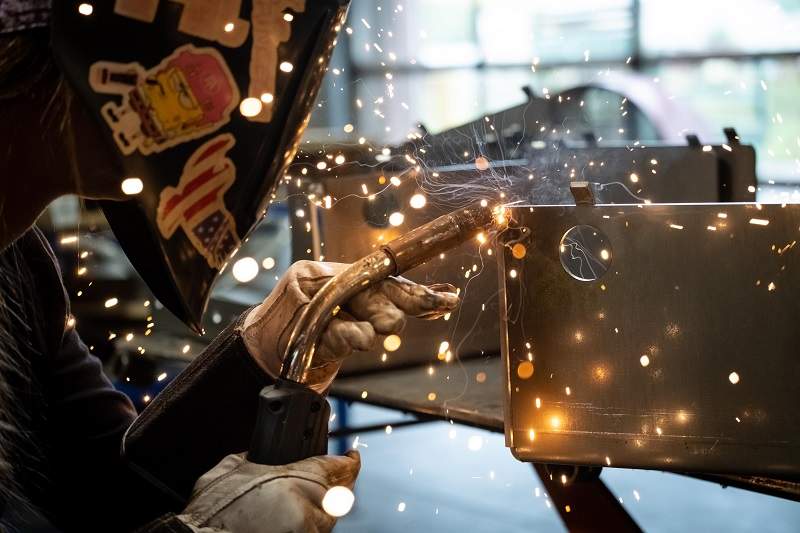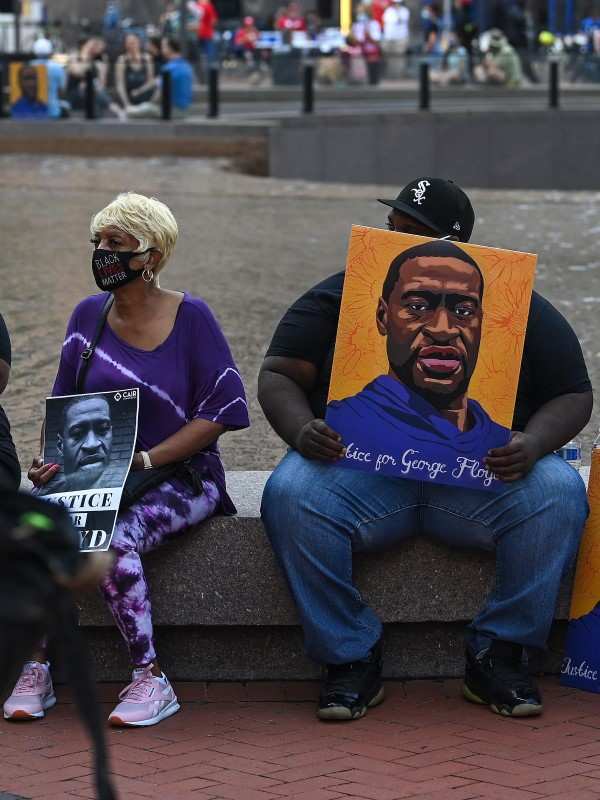Record hot labor market has Minnesota scrambling for workers

Tealy Krosch, 19, of Lake Crystal, welds together metal parts on Aug. 25, 2022 at Jones Metal in Mankato, Minnesota.
16:57 JST, September 5, 2022
MANKATO, Minn. – A construction company needs workers so badly, they’re flying them in from Puerto Rico and from Texas and paying $20 an hour to install roofs. An online Halloween costume retailer booked hundreds of hotel rooms across the city to house its seasonal workforce.
Welcome to Mankato, Minnesota, home to one of the tightest labor markets in the nation. The unemployment rate in this metro area of 103,000 is even lower than the state average of 1.8% – a record low since federal labor statistics began tracking data, and far below the national average of 3.7%.
The U.S. labor market is in its 20th month of eye-popping job creation, as worker shortages, abundant job growth and mass resignations have become a hallmark of the recovery after the pandemic downturn, helping blunt the pain of widespread inflation.
Minnesota is weathering an extreme version of the tight labor market and low unemployment, which is playing out in fierce battles for workers in manufacturing hubs like Mankato. Jones Metal, a family-owned metal parts factory, is scrambling to hire enough welders to build battery boxes and generators. It pays a starting wage of $23.50 an hour, while trying to automate more jobs to keep the plant running.
“When we were trying to hire last year, just like everybody else, we’d get a candidate in, make a great offer, and then their employer would counter with some ridiculous amount,” said Valerie Bentdahl, director of human resources at Jones Metal.
And outside the manufacturing sector, the going rate for service sector jobs can run well above $15 an hour, according to job postings, state data and interviews with more than 12 restaurants and shops.
“This is the best job I’ve ever had,” said Tate Witty, a senior at Minnesota State University who scoops ice cream at Mom & Pop’s on Riverfront Drive in Mankato, often making more than $17 an hour with tips.
The tight labor market has created an entirely new wage floor, far above the state’s minimum of $8.42 an hour, said Ryan Vesey, economic development specialist at Greater Mankato Growth, the local chamber of commerce.
“Even in fast food. If you’re working full-time at McDonald’s, you can make $15 an hour,” Vesey said. “This is a community where if the minimum wage were to go up, I don’t think it would be noticed.”
Wages have grown so much in leisure and hospitality throughout Minnesota that they have outpaced inflation these past two years, according to the Minnesota Department of Employment and Economic Development, at a time when national inflation rates are wiping out wage gains for most workers.
Even before the pandemic began, Minnesota had long benefited from a red-hot labor market in which employers compete aggressively for workers despite a comparatively plentiful labor force, with a participation rate that’s far higher than the national average.
The state has a fast-growing immigrant population, particularly from Mexico, Somalia and Laos, with large numbers of workers in the labor force. Eighty percent of the state’s Hispanic residents held jobs as of July. Minnesota also boasts one of the nation’s highest high school completion rates, and the 14th-highest college graduation rate.
The state is home to more than a dozen blue-chip companies, ranging from manufacturing to health care, including Target, Best Buy, 3M, UnitedHealth Group and General Mills. The diversity in companies has helped the Minnesota economy weather the pandemic, including the 2020 shutdowns, far better than other states, said Steve Grove, commissioner of the Minnesota Department of Employment and Economic Development.
“Workers have an extraordinary amount of choice right now in Minnesota,” Grove said on a recent press call. “Companies are desperate for workers. Labor is such a prized asset right now in any given firm.”
Signs that employers of all stripes are itching for workers are everywhere in Mankato. Main thoroughfares are dotted with “now hiring” and “help wanted” signs at fast food joints, supermarkets, bars, manufacturing outlets, a barbershop, carwash, shoe store, and smoothie shack.
The KFC on Madison Avenue pays a starting wage of $15 an hour and advertises scholarships and GED opportunities. Hosts and hostesses at Tav on the Ave, a sports bar that is packed during lunch hour, start at $15 or $16 an hour.
Food court concessions and retail stores shut down early or for days on end because no one is willing to work, according to shoppers and other employees at the River Hills Mall.
The labor market has gotten so tight in recent years that employers say raising wages and increasing benefits is not enough and that they are turning to new tactics, such as automating work to reduce head count and dipping into new labor pools. One firm has convinced a local university to alert students with push notifications about job openings.
Jones Metal, a beloved employer, saw a wave of departures last year, at a rate of 1 out of 3 workers. Even longtime welders who had been around for decades quit in search of new opportunities. To find workers, Jones Metal has partnered with local colleges and high schools to sponsor classes and applied for state grants that offer welders free college tuition. Still, filling welding and machining jobs can take months.
When he was 20, Thomas Lawton, a welder at Jones Metal, could afford to buy a four-bedroom house with a two-car garage on the Minnesota River, where he catches catfish in the evenings. Now 22, he makes enough, at $24.50 an hour, to set aside 15% of his income in a retirement account.
“I’m very comfortable,” Lawton said, noting that manufacturers and health-care employers began to court him and his peers in Mankato when they were teenagers. “There’s lots of opportunity here.”
Schwickert’s Tecta America, a roofing construction company based in Mankato, has flown in more than 60 laborers from Texas and Puerto Rico in recent years to keep up with the demands of the booming construction industry. It has also raised entry-level wages to $20 an hour, and pays relocation expenses and initial housing costs. The company sponsors a roofing course at Texas Southmost College in Brownsville, guaranteeing jobs in Minnesota or Kansas. Some of the Texas workers have relocated permanently, although many of the workers from Puerto Rico have since returned to the territory, citing homesickness.
Bertha Cuellar, 41, who became homeless in Brownsville during the pandemic when her remodeling business tanked, came across the Schwickert’s Tecta America roofing course. Two days after she completed the program in May, Cuellar boarded a flight to a new life in Minnesota.
“This was a big move,” Cuellar said. “It was a major change going from making $9 or $10 an hour to $22 an hour. I came over here with nothing, not even money in my pocket. But now I’m way more comfortable. I got a car now. I’m looking for an apartment.”
Fun.com, a Mankato-based company, sells some $500 million worth of Halloween costumes each October. The company spent a million dollars last year to bring in 275 seasonal workers from across the Midwest, paying for lodging and a shuttle to transport them from hotels to its sprawling fulfillment center on the north side of town. They filled nearly every hotel room in the city.
This year, the company plans to bring in 50 seasonal workers from out of town. It has also doubled starting wages for warehouse workers who pick and pack orders to $20 an hour, offering an extra $5 an hour for peak sales days leading up to Halloween.
“The alternative [to investing in our workforce] was a downturn in sales, which would mean not marketing as much or raising prices,” said Matthew Burkett, the company’s chief financial officer. “Basically it was like, ‘We got to get people.’ And it worked. We’ve had a record year, so it was the right move to do.”
To attract Somali workers, local employers in manufacturing and food production have designed foot baths and prayer rooms for their warehouses, and added fans during Ramadan.
“Businesses want more workers, so they are making these renovations to their buildings,” said Mohamed Abdulkadir, refugee employment specialist for Blue Earth County, who helps match Somali workers with employers in the area, in part by serving as an interpreter.
The hot labor market has not improved life for all Minnesota workers equally. In African American and Somali immigrant communities in Minneapolis, some workers have received pay boosts, while others still struggle to find good-paying jobs for a variety of reasons, including a lack of child care, run-ins with the justice system, low education levels, and language barriers. The cost of living in the urban center is significantly higher than in Mankato, leaving many struggling.
The Black unemployment rate in Minnesota in July was 7.3%, more than triple the White unemployment rate, and worse than the national average for Black people in the United States.
“Sad to say, in the African American community, I don’t see a lot of people taking on new, better-paying jobs,” said Charles Moss, an employment services manager at Project for Pride in Living, a nonprofit in north Minneapolis, where most residents are African American.

People attend a remembrance rally for George Floyd outside the Hennepin County Government Center on May 23, 2021, in Minneapolis, Minnesota.
Thousands of Black people in Minneapolis lost jobs during the pandemic and lived at the epicenter of an uprising and national reckoning over racism, after the murder of George Floyd by a Minneapolis police officer in 2020.
Tasha, 34, lost her job during the pandemic; she had been a tool-kit assistant aiding engineers at Boston Scientific, a biomedical engineering company. Since then, she has struggled to find a good-paying job in Minneapolis to support herself and her daughter, as inflation soars and her husband serves out a prison sentence.
“It’s easy to find work that is very low pay and high risk for covid,” said Tasha, who has hypertension and other health issues. “You can find something in fast food or gas stations, places where you deal with the general public, but I’m not willing to do that.” Tasha asked to be identified by her first name only because she feared jeopardizing her job prospects.
For over a year, she has strung together independent contractor gigs as a banquet server at the Minneapolis Convention Center and a temp worker fulfilling gift card orders for $15 to $17 an hour. Recently, she completed a course for a commercial driver’s license and is hopeful that she’ll land a full-time job in the trucking industry.
“I feel that for the African American community in Minneapolis, it’s harder,” she said. “The good paying jobs are far out and there’s a lack of transportation to get to them.”





